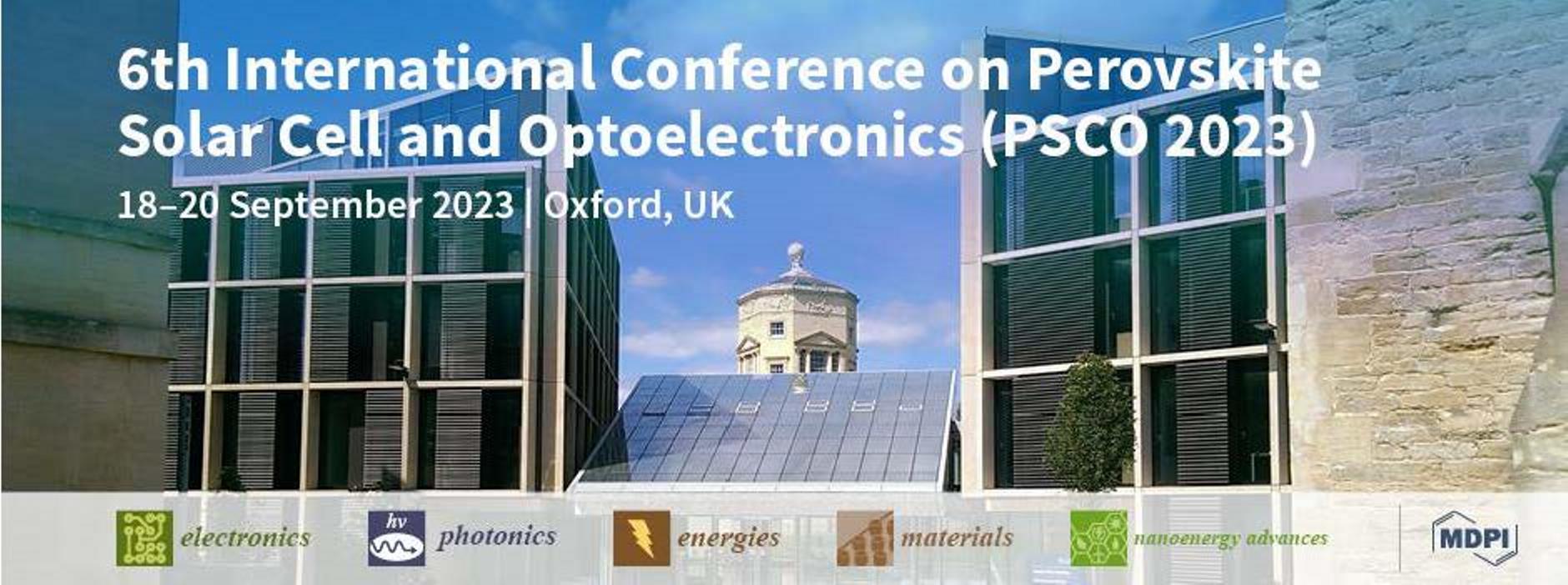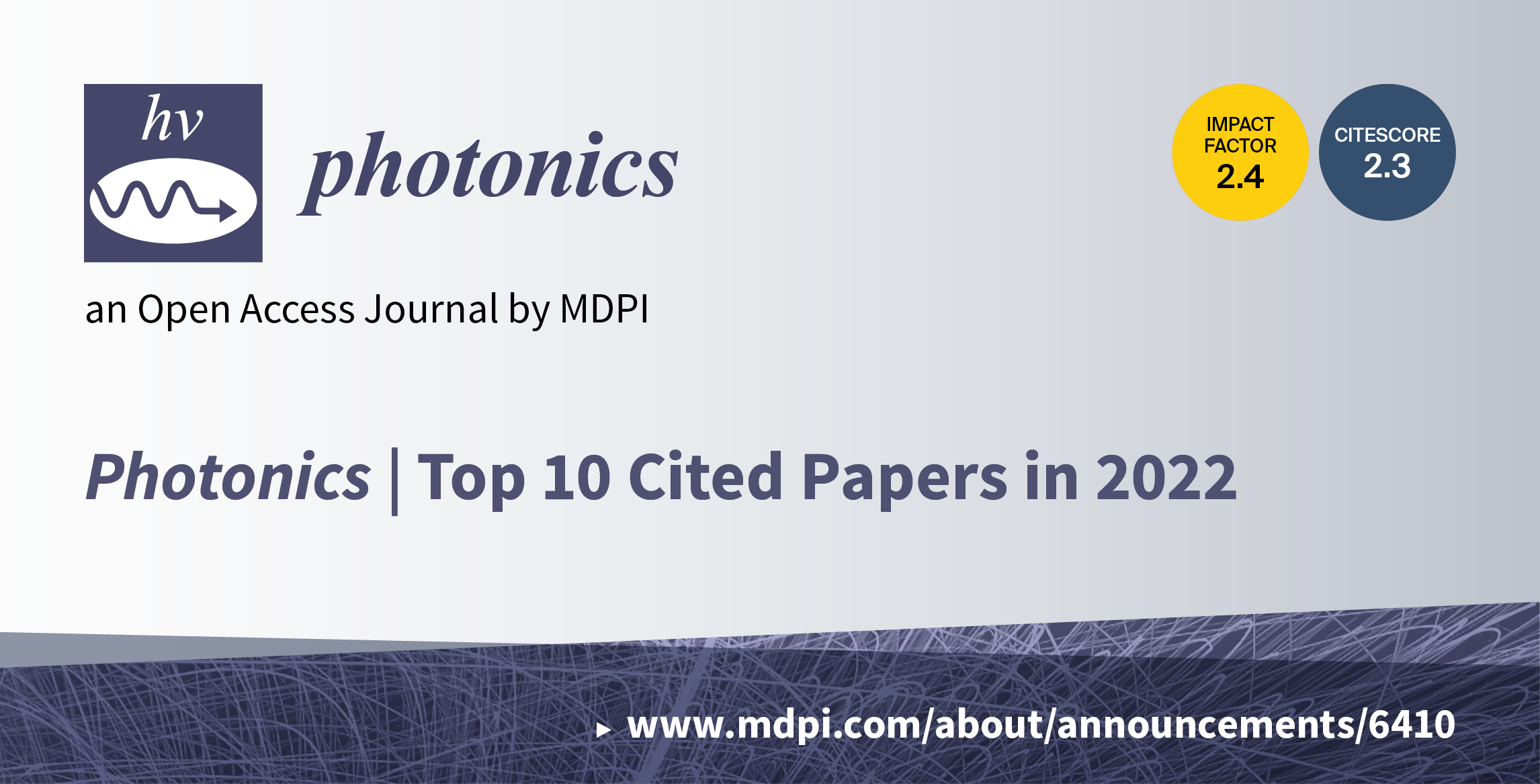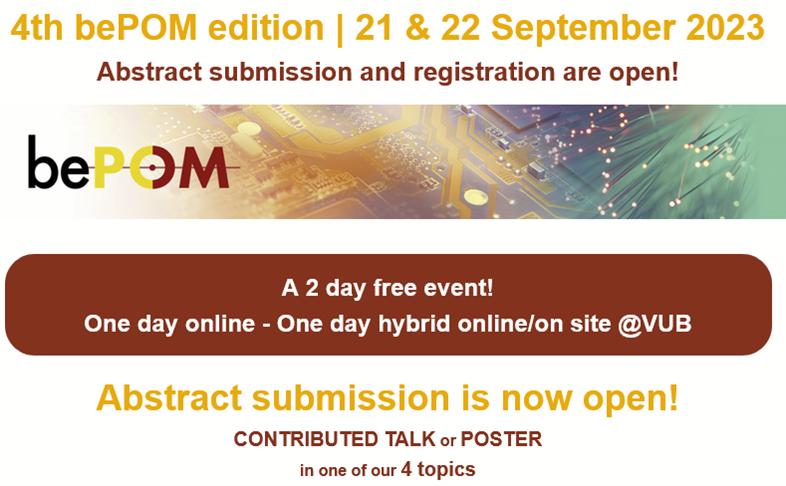-
 Two-Stage Link Loss Optimization of Divergent Gaussian Beams for Narrow Field-of-View Receivers in Line-of-Sight Indoor Downlink Optical Wireless Communication (Invited)
Two-Stage Link Loss Optimization of Divergent Gaussian Beams for Narrow Field-of-View Receivers in Line-of-Sight Indoor Downlink Optical Wireless Communication (Invited) -
 Ultrafast Charge Dynamics in Bulk Zinc Oxide under Intense Photoexcitation
Ultrafast Charge Dynamics in Bulk Zinc Oxide under Intense Photoexcitation -
 Efficient LED-Array Optical Wireless Power Transmission System for Portable Power Supply and Its Compact Modularization
Efficient LED-Array Optical Wireless Power Transmission System for Portable Power Supply and Its Compact Modularization
Journal Description
Photonics
Photonics
is an international, scientific, peer-reviewed, open access journal on the science and technology of optics and photonics, published monthly online by MDPI.
- Open Access— free for readers, with article processing charges (APC) paid by authors or their institutions.
- High Visibility: indexed within Scopus, SCIE (Web of Science), Inspec, CAPlus / SciFinder, and other databases.
- Rapid Publication: manuscripts are peer-reviewed and a first decision is provided to authors approximately 15.7 days after submission; acceptance to publication is undertaken in 2.8 days (median values for papers published in this journal in the first half of 2023).
- Recognition of Reviewers: reviewers who provide timely, thorough peer-review reports receive vouchers entitling them to a discount on the APC of their next publication in any MDPI journal, in appreciation of the work done.
- Companion journal: Optics.
Impact Factor:
2.4 (2022);
5-Year Impact Factor:
2.4 (2022)
Latest Articles
Machine Learning for Self-Coherent Detection Short-Reach Optical Communications
Photonics 2023, 10(9), 1001; https://doi.org/10.3390/photonics10091001 (registering DOI) - 31 Aug 2023
Abstract
Driven by emerging technologies such as the Internet of Things, 4K/8K video applications, virtual reality, and the metaverse, global internet protocol traffic has experienced an explosive growth in recent years. The surge in traffic imposes higher requirements for the data rate, spectral efficiency,
[...] Read more.
Driven by emerging technologies such as the Internet of Things, 4K/8K video applications, virtual reality, and the metaverse, global internet protocol traffic has experienced an explosive growth in recent years. The surge in traffic imposes higher requirements for the data rate, spectral efficiency, cost, and power consumption of optical transceivers in short-reach optical networks, including data-center interconnects, passive optical networks, and 5G front-haul networks. Recently, a number of self-coherent detection (SCD) systems have been proposed and gained considerable attention due to their spectral efficiency and low cost. Compared with coherent detection, the narrow-linewidth and high-stable local oscillator can be saved at the receiver, significantly reducing the hardware complexity and cost of optical modules. At the same time, machine learning (ML) algorithms have demonstrated a remarkable performance in various types of optical communication applications, including channel equalization, constellation optimization, and optical performance monitoring. ML can also find its place in SCD systems in these scenarios. In this paper, we provide a comprehensive review of the recent progress in SCD systems designed for high-speed optical short- to medium-reach transmission links. We discuss the diverse applications and the future perspectives of ML for these SCD systems.
Full article
(This article belongs to the Special Issue Machine Learning Applied to Optical Communication Systems)
►
Show Figures
Open AccessFeature PaperArticle
Annular Gray Tone Lithography for the Fabrication of Rotationally Symmetric Continuous Relief Meso- and Microscale Optical Elements
by
, , , , and
Photonics 2023, 10(9), 1000; https://doi.org/10.3390/photonics10091000 (registering DOI) - 31 Aug 2023
Abstract
►▼
Show Figures
Annular lithography is a recently introduced, flexible technique that has been tailored to the fabrication of rotationally symmetric optical structures in the meso and micro range. The optical concept for the exposure tool is based on a combination of axicons with movable components
[...] Read more.
Annular lithography is a recently introduced, flexible technique that has been tailored to the fabrication of rotationally symmetric optical structures in the meso and micro range. The optical concept for the exposure tool is based on a combination of axicons with movable components that create a ring-shaped light distribution with variable diameter in the image plane. This contribution demonstrates for the first time the use of gray tone exposure in annular lithography to fabricate continuous relief structures, overcoming the previous limitation using binary structures. For the controlled exposure of the continuous relief structures, the sensitivity curve of the resist, the exposure dose decreasing with increasing ring diameter, and the exposure time have to be considered. A control and simulation tool is introduced to provide radius-dependent exposure data and, furthermore, to control and iteratively improve the fabricated structures. To demonstrate the gray tone capabilities, various diffractive elements as well as refractive spherical and aspherical elements with a maximum diameter of ~6 mm and a maximum height of 4 µm are shown as examples. Profile shape measurements of fabricated elements show good agreement with the expectations.
Full article
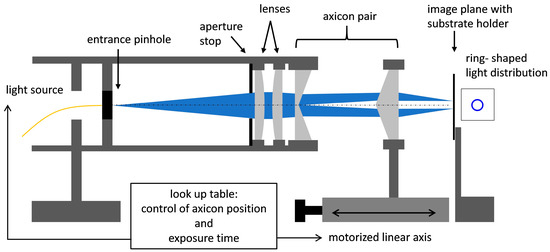
Figure 1
Open AccessReview
Lasers in Medicine: The Changing Role of Therapeutic Laser-Induced Retinal Damage—From de rigeuer to Nevermore
Photonics 2023, 10(9), 999; https://doi.org/10.3390/photonics10090999 - 31 Aug 2023
Abstract
For over five decades, laser-induced retinal damage (LIRD) was thought to be the necessary cost of all therapeutic effects of laser treatment for the most important causes of irreversible visual loss, the chronic progressive retinopathies (CPRs). The development of modern retinal laser therapy
[...] Read more.
For over five decades, laser-induced retinal damage (LIRD) was thought to be the necessary cost of all therapeutic effects of laser treatment for the most important causes of irreversible visual loss, the chronic progressive retinopathies (CPRs). The development of modern retinal laser therapy with the discovery of “low-intensity/high-density subthreshold micropulse” laser (SDM) showed that the supposed need for LIRD represented a case of confusing association with causation. This revealed that LIRD was unnecessary and detrimental to clinical outcomes, and thus, contraindicated as the most severe complication of retinal laser treatment. SDM allowed for an understanding of the mechanism of retinal laser treatment as a physiologic reset effect, triggered by heat-shock protein (HSP) activation upregulating the unfolded protein response and restoring proteostasis by increasing protein repair by 35% in dysfunctional cells via a thermally sensitive conformational change in the K10 step of HSP activation kinetics. Because HSP activation kinetics are catalytic, even low levels (the “reset” threshold) of HSP activation result in a maximal treatment response. SDM and the study of HSP activation kinetics in the retina show that the therapeutic effects of retinal laser treatment can be fully realized without any degree of LIRD. Besides LIRD, all effects of retinal laser treatment are restorative and therapeutic, without any known adverse treatment effects. Without LIRD, the benefits of retinal laser treatment are infinitely renewable and direct treatment of the fovea is possible. Elimination of LIRD from retinal laser treatment has revolutionized the clinical potential of retinal laser treatment to broaden treatment indications to permit, for the first time, effective early and preventive treatment to reduce visual loss from the most frequent causes of irreversible visual loss worldwide, the CPRs.
Full article
(This article belongs to the Special Issue Laser-Induced Damage)
►▼
Show Figures
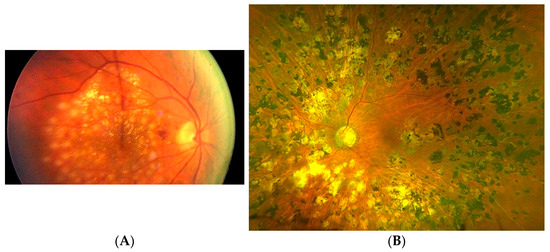
Figure 1
Open AccessCommunication
High-Performance Metamaterial Light Absorption from Visible to Near-Infrared Assisted by Anti-Reflection Coating
Photonics 2023, 10(9), 998; https://doi.org/10.3390/photonics10090998 - 31 Aug 2023
Abstract
►▼
Show Figures
This study experimentally demonstrates two types of ultra-broadband metamaterial absorbers with high performance in the visible-to-near-infrared range by using different anti-reflection coatings (i.e., SiO2 and Si3N4) and a multi-subcell Ti-SiO2-Ti metasurface. Compared to the bare metamaterial
[...] Read more.
This study experimentally demonstrates two types of ultra-broadband metamaterial absorbers with high performance in the visible-to-near-infrared range by using different anti-reflection coatings (i.e., SiO2 and Si3N4) and a multi-subcell Ti-SiO2-Ti metasurface. Compared to the bare metamaterial nanostructure, the absorption bandwidth of the coated metasurfaces exhibit increases of 594 nm and 1093 nm, respectively. Such improvements benefit from nearly perfect impedance matching to the free space enhanced by the anti-reflection coating, thin film interference, and excitations of different surface plasmon resonances. As a result, the absorber with SiO2 coating exhibits a measured bandwidth with an absorption of 0.9 ranging from 502 nm to 1892 nm, while the absorber with Si3N4 coating further broadens the bandwidth from 561 nm to 2450 nm. The measured average absorptions for both cases remain above 95% and 87%, respectively. Moreover, both nanostructures are robust to large incident angles of up to 60° for both TE and TM modes. Our findings highlight the promising potential of these absorbers for various applications, including solar energy harvesting, thermal emitters, and photodetectors.
Full article
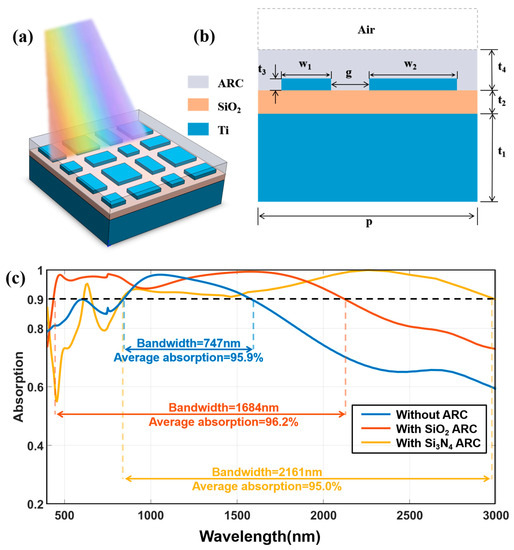
Figure 1
Open AccessFeature PaperArticle
Laser Output Performance and Temporal Quality Enhancement at the J-KAREN-P Petawatt Laser Facility
Photonics 2023, 10(9), 997; https://doi.org/10.3390/photonics10090997 - 31 Aug 2023
Abstract
We described the output performance and temporal quality enhancement of the J-KAREN-P petawatt laser facility. After wavefront correction using a deformable mirror, focusing with an f/1.3 off-axis parabolic mirror delivered a peak intensity of 1022 W/cm2 at 0.3 PW power levels.
[...] Read more.
We described the output performance and temporal quality enhancement of the J-KAREN-P petawatt laser facility. After wavefront correction using a deformable mirror, focusing with an f/1.3 off-axis parabolic mirror delivered a peak intensity of 1022 W/cm2 at 0.3 PW power levels. Technologies to improve the temporal contrast were investigated and tested. The origins of pre-pulses generated by post-pulses were identified and the elimination of most pre-pulses by removal of the post-pulses with wedged optics was achieved. A cascaded femtosecond optical parametric amplifier based on the utilization of the idler pulse rather than the signal pulse was developed for the complete elimination of the remaining pre-pulses. The orders of magnitude enhancement of the pedestal before the main pulse were obtained by using a higher surface quality of the convex mirror in the Öffner stretcher. A single plasma mirror was installed in the J-KAREN-P laser beam line for further contrast improvement of three orders of magnitude. The above developments indicate, although it has not been directly measured, the contrast can be as high as approximately 1015 up to 40 ps before the main pulse. We also showed an overview of the digital transformation (DX) of the system, enabling remote and automated operation of the J-KAREN-P laser facility.
Full article
(This article belongs to the Special Issue Ultrashort Ultra-Intense (Petawatt) Laser)
►▼
Show Figures
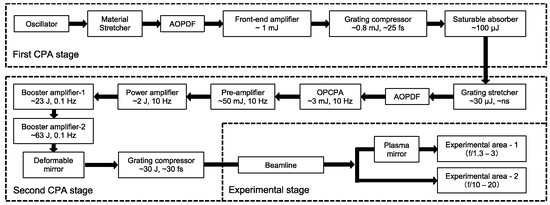
Figure 1
Open AccessArticle
Influence of Adhesive Bonding on the Dynamic and Static Strain Transfers of Fibre Optic Sensors
by
, , , , , and
Photonics 2023, 10(9), 996; https://doi.org/10.3390/photonics10090996 - 31 Aug 2023
Abstract
The influence of the bonding procedure (the adhesive type, application procedure, etc.) on the static and dynamic strain transfers of bonded optical fibre sensors is studied theoretically and experimentally at room temperature. The achievable performances with four different types of adhesives (three urethane
[...] Read more.
The influence of the bonding procedure (the adhesive type, application procedure, etc.) on the static and dynamic strain transfers of bonded optical fibre sensors is studied theoretically and experimentally at room temperature. The achievable performances with four different types of adhesives (three urethane and one epoxy adhesive), and with different fibre types, are evaluated: acrylate-coated, polyimide-coated, and bare single-mode optical fibres. Static strain measurements, ranging from 20 to 200 µ strain, are performed using both fibre Bragg gratings (FBGs) and optical frequency domain reflectometry (OFDR), and are compared to reference strain-gauge measurements, and to the proposed analytical model, which is developed on the basis of stress equilibrium relations. This model is valid for bonding to all types of linear and elastic materials, as long as there is no sliding between the host material, the adhesive, and the optical fibre. The results agree between the analytical model and the experiments. Regarding the dynamic sinusoidal strain measurements, the studied dynamic range is from 10 to 100 Hz, and only the FBGs are tested. The results demonstrate that the sensitivities of strain sensors based on bonded uncoated fibres or bonded polyimide-coated fibres are comparable to those of strain gauges, and that it is possible to use bonded FBGs for precise dynamic strain measurements.
Full article
(This article belongs to the Special Issue Editorial Board Members’ Collection Series: Photonics Sensors)
►▼
Show Figures
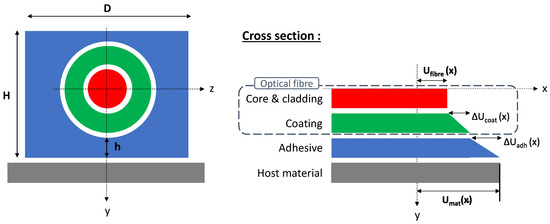
Figure 1
Open AccessCommunication
Fe2O3 Nanoparticle-Based Q-Switched Pulse Fiber Laser
by
, , , , and
Photonics 2023, 10(9), 995; https://doi.org/10.3390/photonics10090995 - 31 Aug 2023
Abstract
We demonstrate the utilization of iron oxide (Fe2O3) as light-absorbing material in an erbium-doped fiber laser (EDFL) for the generation of Q-switched pulses. A sandwich-type saturable absorber (SA) with Fe2O3 nanoparticles between fiber ferrules is proposed.
[...] Read more.
We demonstrate the utilization of iron oxide (Fe2O3) as light-absorbing material in an erbium-doped fiber laser (EDFL) for the generation of Q-switched pulses. A sandwich-type saturable absorber (SA) with Fe2O3 nanoparticles between fiber ferrules is proposed. A fiber ferrule tip is tapped onto a cap of index-matching gel, which is then dipped into Fe2O3 nanoparticle powder to allow its deposition through the adhesion effect. By incorporating Fe2O3–SA in an EDFL, self-started and stable Q-switched pulses are attained at a threshold power of 50.1 mW. The pulse repetition rate is tunable from 9.92 kHz to 22.47 kHz, whereas the pulse duration reduces from 38.4 µs to 13.8 µs with the pump power increment. The maximum pulse energy achieved is 36.9 nJ. This work offers a simple integration method of Fe2O3 nanoparticles as potential SAs for the generation of Q-switched pulses.
Full article
(This article belongs to the Special Issue Optical Fiber Lasers and Amplifiers. Practical Applications of Fiber-Based Laser Sources)
►▼
Show Figures

Figure 1
Open AccessArticle
Comparison of the Real Part of Dielectric Constants with Different Materials to Decrease the Emittance and a Virtual Dielectric Constant to Reproduce Reflectance
by
, , , and
Photonics 2023, 10(9), 994; https://doi.org/10.3390/photonics10090994 - 31 Aug 2023
Abstract
►▼
Show Figures
This paper analyzes how the real part of the dielectric constant affects the emittance or temperature in some materials. A two-layer configuration was implemented on a glass substrate, with theory and experiment, on a sunny day in Mexico. Furthermore, the transfer matrix method
[...] Read more.
This paper analyzes how the real part of the dielectric constant affects the emittance or temperature in some materials. A two-layer configuration was implemented on a glass substrate, with theory and experiment, on a sunny day in Mexico. Furthermore, the transfer matrix method was used as theory, changing the material on the top of the substrate and below a film of zinc sulfide. As a result, for a larger real part of the dielectric constant, the emittance decreased in analytical results, and therefore a decrease in temperature was obtained in the experiment. Furthermore, a virtual dielectric constant was obtained from the experimental reflectance in a bilayer system reproducing this system analytically with one layer having different thickness. The finite-difference time-domain (FDTD) method was used to obtain the optimal length of equilateral pyramids on the surface of a flat film by changing the materials to improve the reflectance or decrease the emittance. It was concluded that for a wavelength of the incident source, optimal dimensions of the triangles on the surface exist.
Full article
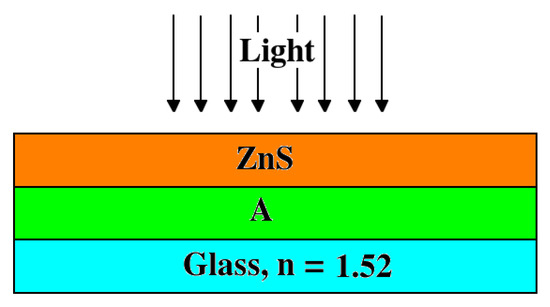
Figure 1
Open AccessReview
Visible Light Communications: A Survey on Recent High-Capacity Demonstrations and Digital Modulation Techniques
Photonics 2023, 10(9), 993; https://doi.org/10.3390/photonics10090993 - 30 Aug 2023
Abstract
In order to deal with the increasing number of mobile devices and with their demand for Internet services, particularly social media platforms, streaming video, and online gaming, Radio-Frequency (RF) wireless networks have been pushed to their capacity limits. In addition to this, 80%
[...] Read more.
In order to deal with the increasing number of mobile devices and with their demand for Internet services, particularly social media platforms, streaming video, and online gaming, Radio-Frequency (RF) wireless networks have been pushed to their capacity limits. In addition to this, 80% of the total data traffic is carried out by users inside buildings. Therefore, new technologies have started to be considered for indoor wireless communications. Visible Light Communications (VLC) can provide both illumination and communications, appearing as an alternative or complement to RF wireless networks. VLC offers high bandwidth and immunity to interference from electromagnetic sources. This manuscript reviews recent high-capacity VLC demonstrations. The main focus of this work is to present digital-signal-processing techniques used in VLC systems. Different modulation formats are analyzed, which can be divided into two large groups, namely single-carrier and multi-carrier modulation schemes. Finally, some recently proposed capacity-achieving strategies are presented. We discuss how to implement these techniques and how they will be useful for the continued development of VLC systems.
Full article
(This article belongs to the Special Issue Advances in Visible Light Communication)
►▼
Show Figures

Figure 1
Open AccessArticle
The Topological Origin of Boundary Charges at Edges of One-Dimensional Crystals without Inversion Symmetry
Photonics 2023, 10(9), 992; https://doi.org/10.3390/photonics10090992 - 30 Aug 2023
Abstract
►▼
Show Figures
We report the edge states and non-zero boundary charges in one-dimensional photonic crystals (1D PhCs) without inversion symmetry. In contrast to common 1D systems, we show that edge states corresponding to non-zero boundary charges do exist in these asymmetric 1D PhCs even if
[...] Read more.
We report the edge states and non-zero boundary charges in one-dimensional photonic crystals (1D PhCs) without inversion symmetry. In contrast to common 1D systems, we show that edge states corresponding to non-zero boundary charges do exist in these asymmetric 1D PhCs even if we cannot obtain non-integral topological invariants. Moreover, an edge state could be observed in the interface between the PhC without inversion symmetry and the well-defined trivial PhC. Finally, the origin of the non-quantized boundary charges is unveiled by the non-central Wannier center. Not only exact solutions of photonic systems, but the above topological phenomena can also be found in the tight-binding models. This work proposes a way to study the 1D symmetries-broken systems and provides models to show the topological origin of boundary charges, which is suitable for both classic systems and quantum systems.
Full article
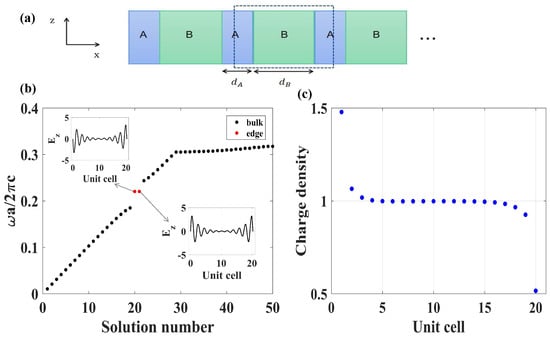
Figure 1
Open AccessArticle
Higher-Order Optomechanical Nonlinearity Based on the Mechanical Effect of Light
by
and
Photonics 2023, 10(9), 991; https://doi.org/10.3390/photonics10090991 - 30 Aug 2023
Abstract
►▼
Show Figures
Nonlinear cavity optomechanics based on the mechanical effect of light has recently received considerable attention due to its potential applications in high-precision metrology. In this work, we theoretically studied the third-order optomechanical nonlinearity by using a perturbative approach, and an analytical solution is
[...] Read more.
Nonlinear cavity optomechanics based on the mechanical effect of light has recently received considerable attention due to its potential applications in high-precision metrology. In this work, we theoretically studied the third-order optomechanical nonlinearity by using a perturbative approach, and an analytical solution is given, which can be extended to cases of higher-order optomechanical nonlinearity. Furthermore, the generation of a third-order sideband is analyzed in detail, and the results show that the amplitude of the third-order sideband shows a high dependence on the control field detuning, suggesting that the high-order nonlinear intensity can be enhanced by properly adjusting the detuning of the laser field rather than by a strong laser drive. In addition to providing insight into optomechanical nonlinearity, the analytical description of third-order optomechanical nonlinearity based on the mechanical effects of light may find applications in ultra-high precision measurement under low power conditions.
Full article
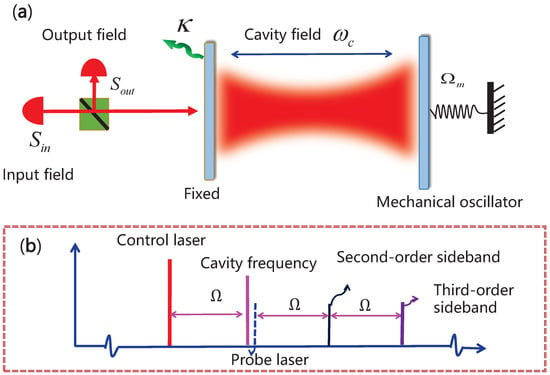
Figure 1
Open AccessArticle
Study of Field Enhancement in the Subnanometer Gap of Plasmonic Dimers Accounting for the Surface Quantum Effect
by
and
Photonics 2023, 10(9), 990; https://doi.org/10.3390/photonics10090990 - 30 Aug 2023
Abstract
►▼
Show Figures
We investigate the influence of the surface quantum effect on the optical characteristics of a plasmonic dimer consisting of two identical gold nanoparticles with a tiny gap. To account for the corresponding surface quantum effect, an electromagnetic theory based on mesoscopic boundary conditions
[...] Read more.
We investigate the influence of the surface quantum effect on the optical characteristics of a plasmonic dimer consisting of two identical gold nanoparticles with a tiny gap. To account for the corresponding surface quantum effect, an electromagnetic theory based on mesoscopic boundary conditions and surface response functions is used. It is shown that the quantum surface effect leads to a blue shift and damping of the corresponding plasmon resonance. This effect becomes more substantial when the constituent particles are elongated, and the gap size shrinks to subnanometer values. In this case, the difference in the results obtained using the surface response functions and the local response approximation can be up to four times and is accompanied by a spectral blue shift of 10 nm.
Full article
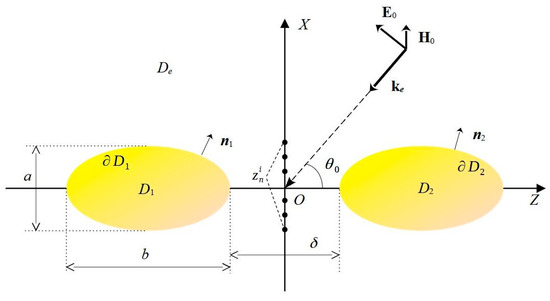
Figure 1
Open AccessArticle
Effects of Acceptors on the Charge Photogeneration Dynamics of PM6-Based Solar Cells
Photonics 2023, 10(9), 989; https://doi.org/10.3390/photonics10090989 - 30 Aug 2023
Abstract
In this work, we investigated the effects of different acceptors (IT−4F and PC71BM) on the charge dynamics in PM6-based solar cells. The correlation between different acceptors and the performance of organic solar cells was studied by atomic force microscope, steady-state absorption
[...] Read more.
In this work, we investigated the effects of different acceptors (IT−4F and PC71BM) on the charge dynamics in PM6-based solar cells. The correlation between different acceptors and the performance of organic solar cells was studied by atomic force microscope, steady-state absorption spectrum, transient absorption spectrum, and electrical measurements. Optical absorption exhibited that IT−4F has strong absorption in the near-infrared region for the active layer. Transient absorption measurements showed that different acceptors (IT−4F and PC71BM) had a significant influence on the behaviors of PM6 excitons and charge dynamics. That is, the exciton dissociation rate and delocalized polaron transport in the PM6:IT−4F active layer were significantly faster than that in the PM6:PC71BM active layer. The lifetime of localized polaron in the PM6:PC71BM active layer was longer than that in the PM6:IT−4F active layer. Conversely, the lifetime of delocalized polaron in the PM6:IT−4F active layer was longer than that in the PM6:PC71BM active layer. Electrical measurement analysis indicated that lower bimolecular recombination, higher charge transport, and charge collection ability were shown in the PM6:IT−4F device compared with the PM6:PC71BM device. Therefore, PM6:IT−4F solar cells achieved a higher power conversion efficiency (12.82%) than PM6:PC71BM solar cells (8.78%).
Full article
(This article belongs to the Special Issue Photophysical Processes in Non-fullerene Organic Solar Cells)
►▼
Show Figures

Figure 1
Open AccessArticle
Benefits of Intelligent Fuzzy Controllers in Comparison to Classical Methods for Adaptive Optics
by
and
Photonics 2023, 10(9), 988; https://doi.org/10.3390/photonics10090988 - 30 Aug 2023
Abstract
Adaptive Optics (AO) systems have been developed throughout recent decades as a strategy to compensate for the effects of atmospheric turbulence, primarily caused by poor astronomical seeing. These systems reduce the wavefront distortions using deformable mirrors. Several AO simulation tools have been developed,
[...] Read more.
Adaptive Optics (AO) systems have been developed throughout recent decades as a strategy to compensate for the effects of atmospheric turbulence, primarily caused by poor astronomical seeing. These systems reduce the wavefront distortions using deformable mirrors. Several AO simulation tools have been developed, such as the Object-Oriented, MATLAB, and Adaptive Optics Toolbox (OOMAO), to assist in the project of AO. However, the main AO simulators focus on AO models, not prioritizing the different control techniques. Moreover, the commonly applied control strategies in ground-based telescopes are based on Integral (I) or Proportional-Integral (PI) controllers. This work proposes the integration of OOMAO models to Simulink to support the development of advanced controllers and compares traditional controllers with intelligent systems based on fuzzy logic. The controllers were compared in three scenarios of different turbulence and atmosphere conditions. The simulations were performed using the characteristics/parameters of the Southern Astrophysical Research (SOAR) telescope and assessed with the Full Width at Half Maximum (FWHM), Half Light Radius (HLR), and Strehl ratio metrics to compare the performance of the controllers. The results demonstrate that adaptive optics can be satisfactorily simulated in OOMAO adapted to Simulink and thus further increase the number of control strategies available to OOMAO. The comparative results between the MATLAB script and the Simulink blocks designed showed a maximum relative error of
(This article belongs to the Special Issue Optical Systems for Astronomy)
►▼
Show Figures
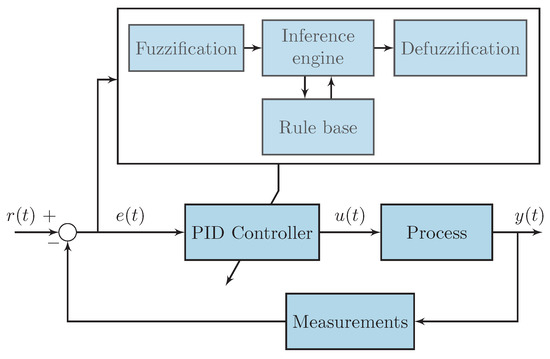
Figure 1
Open AccessTutorial
Single-Shot 3D Incoherent Imaging Using Deterministic and Random Optical Fields with Lucy–Richardson–Rosen Algorithm
by
, , , , , , , and
Photonics 2023, 10(9), 987; https://doi.org/10.3390/photonics10090987 - 30 Aug 2023
Abstract
Coded aperture 3D imaging techniques have been rapidly evolving in recent years. The two main directions of evolution are in aperture engineering to generate the optimal optical field and in the development of a computational reconstruction method to reconstruct the object’s image from
[...] Read more.
Coded aperture 3D imaging techniques have been rapidly evolving in recent years. The two main directions of evolution are in aperture engineering to generate the optimal optical field and in the development of a computational reconstruction method to reconstruct the object’s image from the intensity distribution with minimal noise. The goal is to find the ideal aperture–reconstruction method pair, and if not that, to optimize one to match the other for designing an imaging system with the required 3D imaging characteristics. The Lucy–Richardson–Rosen algorithm (LR2A), a recently developed computational reconstruction method, was found to perform better than its predecessors, such as matched filter, inverse filter, phase-only filter, Lucy–Richardson algorithm, and non-linear reconstruction (NLR), for certain apertures when the point spread function (PSF) is a real and symmetric function. For other cases of PSF, NLR performed better than the rest of the methods. In this tutorial, LR2A has been presented as a generalized approach for any optical field when the PSF is known along with MATLAB codes for reconstruction. The common problems and pitfalls in using LR2A have been discussed. Simulation and experimental studies for common optical fields such as spherical, Bessel, vortex beams, and exotic optical fields such as Airy, scattered, and self-rotating beams have been presented. From this study, it can be seen that it is possible to transfer the 3D imaging characteristics from non-imaging-type exotic fields to indirect imaging systems faithfully using LR2A. The application of LR2A to medical images such as colonoscopy images and cone beam computed tomography images with synthetic PSF has been demonstrated. We believe that the tutorial will provide a deeper understanding of computational reconstruction using LR2A.
Full article
(This article belongs to the Special Issue Correlation Optics)
►▼
Show Figures
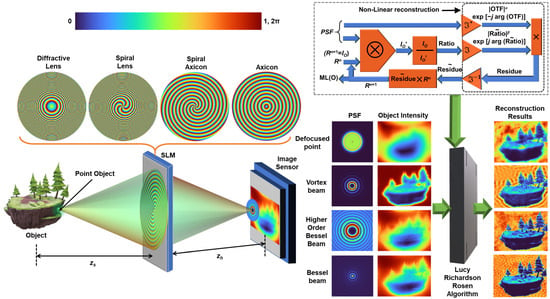
Figure 1
Open AccessArticle
Enhancing the Steady-State Entanglement between a Laguerre–Gaussian-Cavity Mode and a Rotating Mirror via Cross-Kerr Nonlinearity
Photonics 2023, 10(9), 986; https://doi.org/10.3390/photonics10090986 - 30 Aug 2023
Abstract
►▼
Show Figures
Quantum entanglement will play an important role in future quantum technologies. Here, we theoretically study the steady-state entanglement between a cavity field and a macroscopic rotating mirror in a Laguerre–Gaussian-(LG)-cavity optomechanical system with cross-Kerr nonlinearity. Logarithmic negativity is used to quantify the steady-state
[...] Read more.
Quantum entanglement will play an important role in future quantum technologies. Here, we theoretically study the steady-state entanglement between a cavity field and a macroscopic rotating mirror in a Laguerre–Gaussian-(LG)-cavity optomechanical system with cross-Kerr nonlinearity. Logarithmic negativity is used to quantify the steady-state entanglement between the cavity and mechanical modes. We analyze the impacts of the cross-Kerr coupling strength, the cavity detuning, the input laser power, the topological charge of the LG-cavity mode, and the temperature of the environment on the steady-state optomechanical entanglement. We find that cross-Kerr nonlinearity can significantly enhance steady-state optomechanical entanglement and make steady-state optomechanical entanglement more robust against the temperature of the thermal environment.
Full article
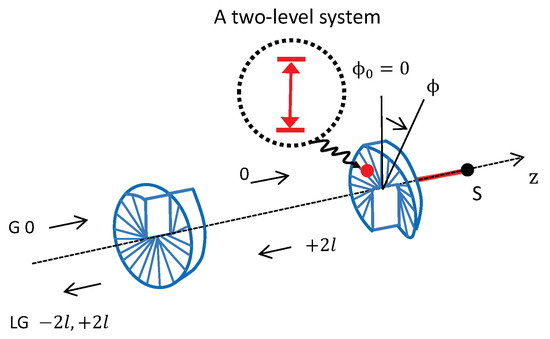
Figure 1
Open AccessArticle
Caries Preventive Action of Nd:YAG and Fluoride in Three Different pH Conditions: FTIR Spectroscopy and SEM Evaluation
by
, , , , , and
Photonics 2023, 10(9), 985; https://doi.org/10.3390/photonics10090985 - 29 Aug 2023
Abstract
This in vitro study aimed to evaluate the preventive action of topical fluoride application combined with laser irradiation under different pH conditions using Fourier Transform Infrared Spectroscopy (FTIR) and Scanning Electron Microscopy (SEM). A total of 180 samples of human dental enamel were
[...] Read more.
This in vitro study aimed to evaluate the preventive action of topical fluoride application combined with laser irradiation under different pH conditions using Fourier Transform Infrared Spectroscopy (FTIR) and Scanning Electron Microscopy (SEM). A total of 180 samples of human dental enamel were prepared and divided into groups: Negative Control, Fluoride (FFA 12.300 µF−/g), Laser (Nd:YAG 84.9 J/cm2), and Laser + Fluoride (Nd:YAG 84.9 J/cm2 + FFA 12.300 µF−/g). The pH cycling was performed at three different pH conditions: pH 5 (below the critical pH for hydroxyapatite), pH 4.5 (below the critical pH in the presence of fluorapatite), and pH 4 (investigating acid resistance of hydroxyapatite and fluorapatite forms with laser irradiation). In the FTIR analysis, the Laser + Fluoride group demonstrated statistically significant differences compared to the Negative Control group and Fluoride group at pH 4.5 and pH 4 when evaluating the phosphate bands. Similar results were observed in the SEM analysis, where the Laser + Fluoride group exhibited lower demineralization compared to the other treatments at pH 4.5 and pH 4. In conclusion, the Laser + Fluoride group demonstrated a significant reduction in demineralization even at pH levels below the critical threshold for fluorapatite, highlighting its superior acid resistance compared to fluoride alone.
Full article
(This article belongs to the Special Issue Clinical Translation of Novel Photonics Technologies: From Fundamental Research to Clinical Practice)
►▼
Show Figures
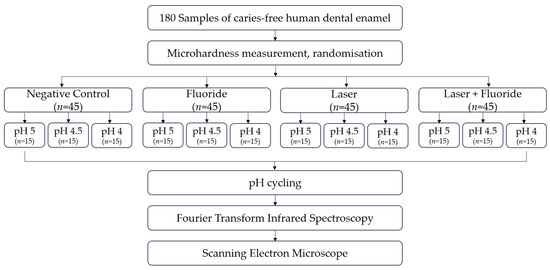
Figure 1
Open AccessArticle
A Machine Learning Approach for Automated Detection of Critical PCB Flaws in Optical Sensing Systems
by
and
Photonics 2023, 10(9), 984; https://doi.org/10.3390/photonics10090984 - 29 Aug 2023
Abstract
The circuit boards in the fields of optical sensors and optical devices require extremely high levels of precision and performance. For instance, applications such as fiber optic communication, optical computing, biomedical devices, and high-performance computing devices all necessitate meticulous optical components. Any minute
[...] Read more.
The circuit boards in the fields of optical sensors and optical devices require extremely high levels of precision and performance. For instance, applications such as fiber optic communication, optical computing, biomedical devices, and high-performance computing devices all necessitate meticulous optical components. Any minute defect on the circuit boards of these components has the potential to adversely impact the performance of the entire device. Traditional circuit defect detection methods require manual inspection, which is very labor-intensive and time-consuming. The defect detection method based on deep learning can automatically learn features and more accurately find defects in printed circuit boards, improve detection efficiency, and reduce the workload, bringing better economic and social benefits. Based on the popular YOLOv8 model, this paper uses the open-source circuit defect dataset, introduces Wise IoU, proposes the W–YOLOv8 model, and uses the gradient gain allocation strategy of a dynamic non-monotonic focusing mechanism to make the model focus on ordinary-quality anchor boxes, which improves the performance of the original model. Experimental data show that the mAP50 of W–YOLOv8 is 97.3%, which is 1.35% higher than that of YOLOv8, and the mAP50-95 is 55.4%, which is 3.94% higher than that of YOLOv8.
Full article
(This article belongs to the Special Issue Optical Sensors: Science and Applications)
►▼
Show Figures
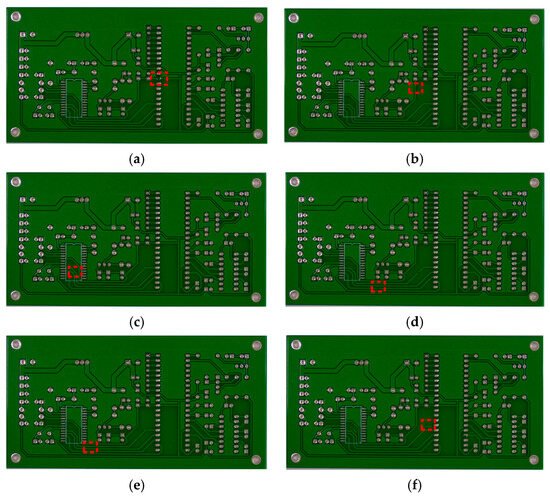
Figure 1
Open AccessArticle
Silica Waveguide Four-Mode Multiplexer Based on Cascaded Directional Couplers
by
, , , , , , and
Photonics 2023, 10(9), 983; https://doi.org/10.3390/photonics10090983 - 28 Aug 2023
Abstract
Mode multiplexers/demultiplexers (MUX/deMUX) are key components in mode division multiplexing. A silica waveguide mode MUX consisting of four cascaded directional couplers is experimentally demonstrated. The beam propagation method is used in the device design and optimization. Thermal oxidation, plasma-enhanced chemical vapor deposition, and
[...] Read more.
Mode multiplexers/demultiplexers (MUX/deMUX) are key components in mode division multiplexing. A silica waveguide mode MUX consisting of four cascaded directional couplers is experimentally demonstrated. The beam propagation method is used in the device design and optimization. Thermal oxidation, plasma-enhanced chemical vapor deposition, and ultraviolet photolithography are adopted in the silica waveguide mode MUX fabrication. The measurement results prove that the input E00 mode can be selectively converted to E10 mode, E20 mode, and E30 mode. Within the wavelength range of 1500 to 1620 nm, the insertion loss is less than 12.2 dB. The proposed mode MUX has good potential in on-chip MDM applications.
Full article
(This article belongs to the Special Issue Photonic Devices Based on Plasmonic or Dielectric Nanostructures)
►▼
Show Figures

Figure 1
Open AccessArticle
Slightly Off-Axis Digital Holography Using a Transmission Grating and GPU-Accelerated Parallel Phase Reconstruction
Photonics 2023, 10(9), 982; https://doi.org/10.3390/photonics10090982 - 28 Aug 2023
Abstract
Slightly off-axis digital holography is proposed using transmission grating to obtain quantitative phase distribution. The experimental device is based on an improved 4f optical system in which a two-window input plane is used to form the object beam and reference beam. Then, the
[...] Read more.
Slightly off-axis digital holography is proposed using transmission grating to obtain quantitative phase distribution. The experimental device is based on an improved 4f optical system in which a two-window input plane is used to form the object beam and reference beam. Then, the two beams are diffracted into multiple orders by the transmission grating placed at the Fourier plane. By applying a modified Michelson configuration, the interference patterns can be generated by the object and reference beams from different diffraction orders. After translating the grating, a random phase shift can be introduced to the hologram. To demonstrate the feasibility of our method, both thick and thin phase specimens are retrieved using two carrier phase-shifting holograms. Furthermore, we use the phase reconstruction algorithm based on the NVIDIA CUDA programming model to reduce the retrieval time. Meanwhile, we optimize the discrete cosine transform (DCT)-based least-squares unwrapping algorithm to unwrap the phase. By porting the entire phase reconstruction process to the graphics processing unit (GPU), the phase retrieval acceleration and execution efficiency significantly improve. To demonstrate the feasibility of our method, it is found that our method can measure the surface profiles of standard elements, such as a plano-convex cylinder lens and a microlens array, with a relative error of about 0.5%. For holograms with a different phase shift, the root-mean-square (RMS) value of the phase difference for the main imaging region is about 0.2 rad. By accelerating the phase reconstruction with GPU implementation, a speedup ratio of about 20× for the thick phase specimen and a speedup ratio of about 15× for the thin-phase specimen can be obtained for holograms with a pixel size of 1024 × 1024.
Full article
(This article belongs to the Special Issue Optical Measurement Systems)
►▼
Show Figures

Figure 1

Journal Menu
► ▼ Journal Menu-
- Photonics Home
- Aims & Scope
- Editorial Board
- Reviewer Board
- Topical Advisory Panel
- Instructions for Authors
- Special Issues
- Topics
- Sections
- Article Processing Charge
- Indexing & Archiving
- Editor’s Choice Articles
- Most Cited & Viewed
- Journal Statistics
- Journal History
- Journal Awards
- Conferences
- Editorial Office
Journal Browser
► ▼ Journal BrowserHighly Accessed Articles
Latest Books
E-Mail Alert
News
Topics
Topic in
Energies, Entropy, Photonics, Technologies, Thermo
Advances in Solar Technologies
Topic Editors: Jayanta Deb Mondol, Annamaria Buonomano, Biplab DasDeadline: 10 November 2023
Topic in
Applied Sciences, Coatings, Materials, Photonics, Sensors
Optical and Optoelectronic Materials and Applications
Topic Editors: Fabian Ambriz Vargas, Jianzhong ZhangDeadline: 30 November 2023
Topic in
Applied Sciences, BDCC, Photonics, Processes, Remote Sensing, Automation
Advances in AI-Empowered Beamline Automation and Data Science in Advanced Photon Sources
Topic Editors: Yi Zhang, Xiaogang Yang, Chunpeng Wang, Junrong ZhangDeadline: 20 December 2023
Topic in
Entropy, Photonics, Physics, Plasma, Universe, Fractal Fract, Condensed Matter
Applications of Photonics, Laser, Plasma and Radiation Physics
Topic Editors: Viorel-Puiu Paun, Eugen Radu, Maricel Agop, Mircea OlteanuDeadline: 30 March 2024

Conferences
27 October–10 November 2023
The 4th International Electronic Conference on Applied Sciences (ASEC2023)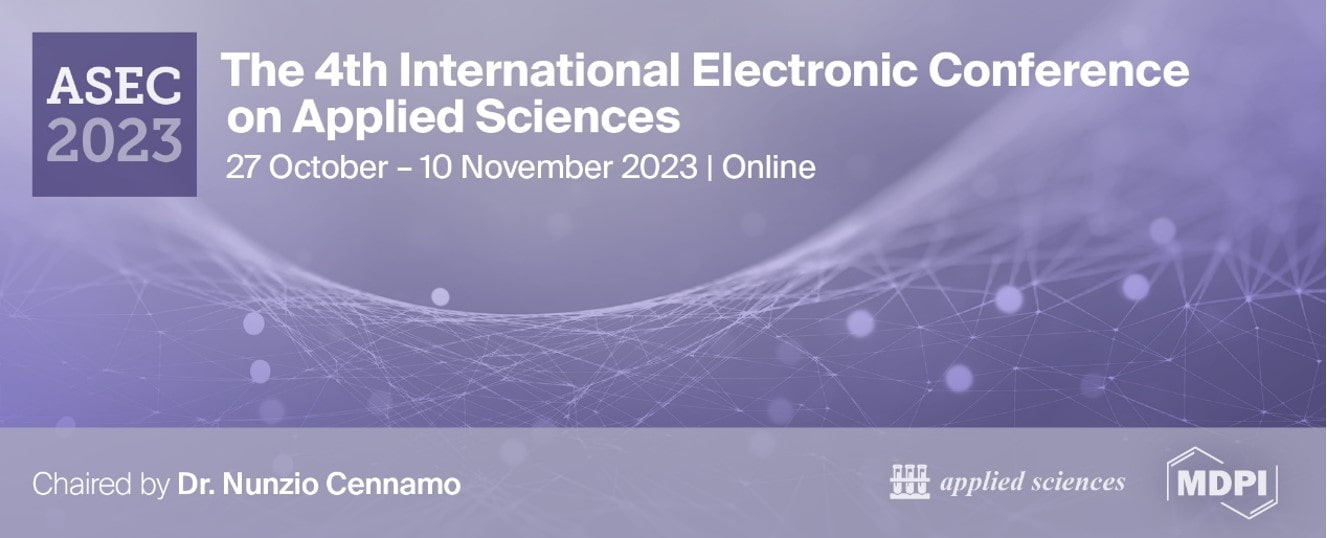

Special Issues
Special Issue in
Photonics
Optical Fiber Lasers and Amplifiers. Practical Applications of Fiber-Based Laser Sources
Guest Editors: Svetlana Aleshkina, Elena Anashkina, Serafima FilatovaDeadline: 1 September 2023
Special Issue in
Photonics
Emerging Frontiers in Photoacoustic Spectroscopy Detection
Guest Editor: Zhen WangDeadline: 20 September 2023
Special Issue in
Photonics
Progress in Neurophotonics and Its Future Perspectives
Guest Editors: Shixie Jiang, Huabei Jiang, Dan WuDeadline: 30 September 2023
Special Issue in
Photonics
Women’s Special Issue Series: Photonics
Guest Editors: Zhaoran (Rena) Huang, Irina Yanina, Frauke Alves, Hongping ZhaoDeadline: 20 October 2023









